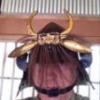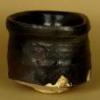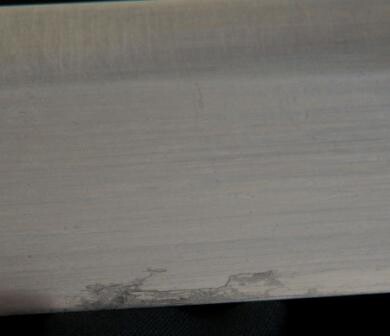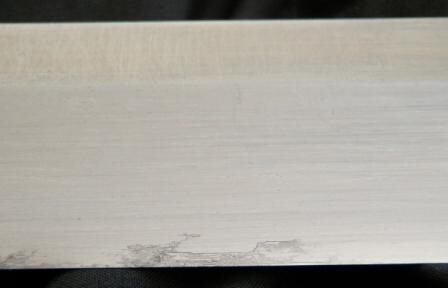Search the Community
Showing results for 'Hagarami'.
-

Mumei Sword - Opinions on Its Provenance Welcome
Rawa replied to Fusilier's topic in General Nihonto Related Discussion
Just add new photos. Dont make them at sunset. Fukure is one point but those chips [hakobore] could come from hagarami. Blade looks like one having plenty of kizu. -
Dear experts, I need your help in "reading" my gendaito blade: a Kaneshige, RJT smith, 1944 star stamped one. Frankly, I got lost with hagarami, hajimi, ware... I noticed a very small "scratch" over the nioi-guchi part of hamon, and also a couple, smaller, close to the ha. They are barely visible naked eyes, and just with a strong light. I got pics with macro; nothing on the corresponding, opposite side of the blade. Could you please tell me what do I have here?
-
Thank you gentlemen. Is a kitae ware different from hagarami? Or same kizu with different placement?
-
My understanding is that while it cannot be repaired, it is not fatal (see: So long as it is not the hagarami some sources describe as a hagire/crack that turns to run parallel to the edge (caused by impact), but rather a ware (a forging flaw).
-

Are horizontal ware in the hamon fatal flaws?
Bugyotsuji replied to JAMJ's topic in General Nihonto Related Discussion
Run a search on Tsuki-no-wa, Hagarami and Kitaé-waré. https://www.militaria.co.za/nmb/search/?&q=Hagarami &search_and_or=and -
Gdaye guys, Just a question about hagarami. Ive read that hagarami are actually kitae-ware that is close to the cutting edge. Is this accurate or is hagarami actually a stress crack like a hagire but on an angle as opposed to being perpendicular to the cutting edge like hagire are? Can anyone show me pictures of hagarami and if all hagarami are fatal? Thanks, Jason G
-
Are horizontal ware in the hamon fatal flaws?
JAMJ replied to JAMJ's topic in General Nihonto Related Discussion
Dear Piers- thank you for referencing the term "Hagarami". That is exactly what I'm talking about, where there is an opening in lamination. It seems there has already been much discussion about it and it doesn't necessarily devalue the blade. With appreciation- -

Are horizontal ware in the hamon fatal flaws?
Bugyotsuji replied to JAMJ's topic in General Nihonto Related Discussion
PS Some months ago I was asking about Hagarami and whether it would automatically fail at Shinsa and after seeing my photo the answer was no, it wouldn’t. -
Hi, I've come across this term here and there and they always describe it as being a variant of an hagire, but is there someone who can explain me more clearly (pref with pic !) exactly what kind of kizu a hagarami is. And is it a fatal flaw ? All my books simply describe it in words and I can't picture it, I'm afraid....
-
Jason, As adam has said flaws such as hagarami has to be taken on case by case basis. My swords hagarami isnt as bad as the ones depicted in the photos, however it is there and visible and close to the edge. However, the nlade itself has alot of niku surrounding the cutting edge which reinforces it somewhat, making it suitable for cutting. Tired blades shouldnt be used for anything other than collecting, regardless if it has flaws such as hagarami. Hope this helps. Kind regards, Jeremy
-
Hi All, I have acquired my first sword - a koto blade which has ware in the hamon (hagarami). However, even with this flaw, the sword received Hozon papers from the NBTHK. I have verified that the sword was polished before it was submitted, so presumably all of its flaws were visible at time of submission. Reading through this thread, it seems that sometimes (most times?) hagarami is considered fatal, so I'm wondering how it was still able to receive Hozon? Any insight would be greatly appreciated. John
-
Thank you for the replies everyone. So is hagarami considered a fatal flaw in an artistic sense or practical sense? Or both? Jeremy, is the blade you use with hagarami a new or old blade? is there any signs of the blade about to break or chip at the flaw point? Thanks, Jason G
-
Hagarami follows a weld, a hagire is usually across welds. One is a forging flaw, the other a crack caused by externally induced stress. Forging flaws can show up after one polish so I am not so sure a hagarami is only seen in tired blades.
-
A good question, especially about being on one side only...I have a WWII gendaito blade by Osaka Okishiba Yoshisada...it has a "c" shaped mark running from the ha into the hamon which I always wondered if it was hagarami...it is like the drawing but is on one side only. The sword would only have had one polish so is not tired, but it was used in combat...so maybe a stress ware? The mark is only noticable as oil seems to congregate there, so it could be just a semicircle of minute pits caused by a drop of water...I just can't be sure. As was asked, can these "hagarami" be on one side only? I can't do a pic sorry...never comes out when I try. Regards,
-
Thanks Kunitaro san. very helpful and informative as usual. So hagarami are seen on tired blades mainly, is that correct? Or can a newly forged blade also have hagarami? Thanks, Jason G
-
What I see in your picture looks like tate ware. Hagarami is a crack similar in nature to hagire, but unlike the latter, it is not perpendicular to the edge.
-
I was agreeing with everything on this thread until you brought up lamination, Kunitaro-san. Do you mean that a hagarami would extend completely into the sanmae/kobuse/shihozume interface/lamination? Ken
-
Newly forged blade shouldn't have any kizu especially in/on Hamon. when smith saw Kizu (opening) in Ha, he will not release the blade.it is fault. the Kizu would show up after over polish. It is not possible to answer without photo. however, If the damage is caused by hitting something hard, it is crack, and if the crack line goes to the edge. then it is Hagire, even if you see only one side, it will goes through other side as well. If you look at kizu with magnifying glass, you will see if it is lamination opening (Hagarami) or crack (Hagire).
-
This photo of the blade has hagarami, but, still looks fine (ji) because, with good polish. Ji is carefully polished that doesn't show rough hada. (if you enlarge photo, maybe you can see lough hada) but, it is tired blade. it should be retired. not for using. but studying.
-
刃絡み Hagarami is the Kitae-ware in/on Hamon. It caused by over polish. showing tiredness as well. normally one side. It is not same as Hagire. Kitae-ware on Ji is possible to repair(close the lamination) sometime, but, Kitae-ware in/on Hamon (Ha-garami) is not possible to do repair.
-
hagarami is not considered a "fatal" flaw in the way a hagire is. Provided the rest of the blade is sound and the mei valid, it should still paper.
-
Hello I have a katana with the following hairline crack in tha hamon. It is about 1cm long. Would this be considered a hagarami and as such a fatal flaw. The crack is not visible on the other side of the balde. The reason i ask is that i intend to take the katana to Shinsa but do not know if am wasting my time as it may be considered a fatal flaw. Obviously the katana needs to meet other standards to pass Shinsa as well. Opinions welcome. Thanks Steve
-
Sorry Stephen, from your "once more" I gather you've given this explanation more than a few times I did however search this forum and it didn't give me any hits on "hagarami". In the books I had, it also spoke of an "oblique" crack, however I didn't fully understand what it meant untill your very descriptive pic from Joly's book. (don't have that book yet) So a well meant "thank you" to you Stephen (and off course also to the rest of you who so willingly answered my rather basic question)
-
Kokan Nagayama defines the two words in much the same way as Brian above. Hagarami: an oblique crack in the cutting edge. (As opposed to Hagire which is vertical)














